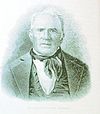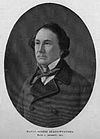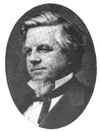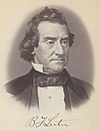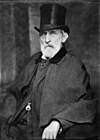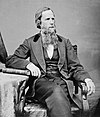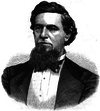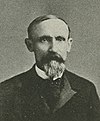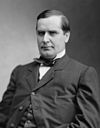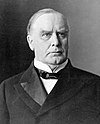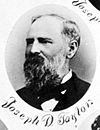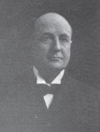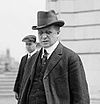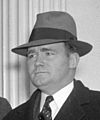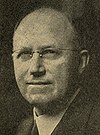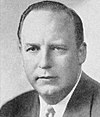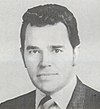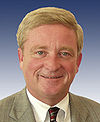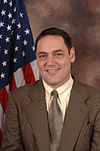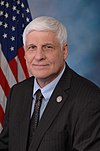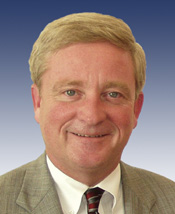
Robert William Ney is an American politician from Ohio. A Republican, Ney represented Ohio's 18th congressional district in the U.S. House of Representatives from 1995 until November 3, 2006, when he resigned. Ney's resignation took place after he pleaded guilty to charges of conspiracy and making false statements in relation to the Jack Abramoff Indian lobbying scandal. Before he pleaded guilty, Ney was identified in the guilty pleas of Jack Abramoff, former Tom DeLay deputy chief of staff Tony Rudy, former DeLay press secretary Michael Scanlon and former Ney chief of staff Neil Volz for receiving lavish gifts in exchange for political favors.
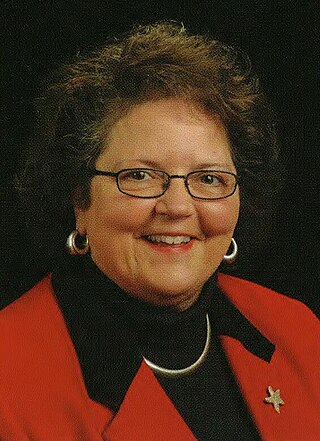
Joy Padgett is a former Republican member of the Ohio Senate, representing the 20th district until the end of 2008. In 2006, dogged by personal scandals, she ran unsuccessfully for Lieutenant Governor of Ohio and for Congress in Ohio's 18th congressional district. Her run for Congress was the result of the decision of Bob Ney to bow out of the race and plead guilty to corruption charges.

West Virginia's 3rd congressional district is an obsolete U.S. congressional district in southern West Virginia. At various times the district covered different parts of the state, but in its final form included the state's second-largest city, Huntington; included Bluefield, Princeton, and Beckley; and has a long history of coal mining, forestry, and farming.

Robert Brian Gibbs is an American politician who served as the U.S. representative for Ohio's 7th congressional district from 2011 to 2023. He is a member of the Republican Party. In April 2022, Gibbs announced he was not seeking reelection.

Florida's 6th congressional district is a congressional district in the U.S. state of Florida. The district is located on the Eastern Florida Coast and stretches from the southern Jacksonville suburbs to New Smyrna Beach. It includes the city of Daytona Beach.
Ohio's 2nd congressional district is a district in southern Ohio. It is currently represented by Republican Brad Wenstrup.
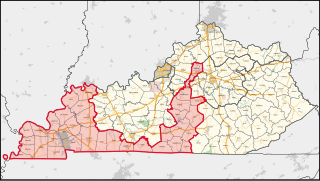
Kentucky's 1st congressional district is a congressional district in the U.S. state of Kentucky. Located in Western Kentucky, and stretching into Central Kentucky, the district takes in Henderson, Hopkinsville, Madisonville, Paducah, Murray, and Frankfort. The district is represented by Republican James Comer who won a special election to fill the seat of Rep. Ed Whitfield who resigned in September 2016. Comer also won election to the regular term to begin January 3, 2017.
Ohio's 3rd congressional district is located entirely in Franklin County and includes most of the city of Columbus. The current district lines were drawn in 2022, following the redistricting based on the 2020 census. It is currently represented by Democrat Joyce Beatty.
Ohio's 4th congressional district spans sections of the central part of the state. It is currently represented by Republican Jim Jordan, the current chair of the House Judiciary Committee, who has represented the district since 2007.
Ohio's 6th congressional district is represented by Representative Bill Johnson (R-OH). This district runs along the eastern side of the state, bordering West Virginia, and Pennsylvania. It stretches from Marietta through several Ohio River industrial towns all the way to the city of Youngstown.
Ohio's 7th congressional district is represented by Max Miller. It is currently located in the northeastern section of the state, including southern and western Cuyahoga County, all of Medina and Wayne Counties, and a sliver of northern Holmes County.
Ohio's 8th congressional district sits on the west side of Ohio, bordering Indiana. The cities of Hamilton, Fairfield, Middletown, Springfield, Eaton, Greenville, Piqua, and Troy are part of the district. The district was represented by Republican John Boehner, the 53rd Speaker of the United States House of Representatives. On September 25, 2015, Boehner announced his resignation from the speakership and retirement from Congress, which became effective on October 31, 2015.
Ohio's 12th congressional district is a United States congressional district in central Ohio, covering Athens County, Coshocton County, Fairfield County, Guernsey County, Knox County, Licking County, Morgan County, Muskingum County and Perry County along with parts of Delaware, Holmes and Tuscarawas counties. The district includes communities east of Columbus including Zanesville, Cambridge, and Mount Vernon. It is currently represented by Troy Balderson, a member of the Republican Party. Balderson took office following a special election held on August 7, 2018, to replace Rep. Pat Tiberi, who had resigned on January 15, 2018. Balderson was then re-elected in the 2018 general election two months later.
The 13th congressional district of Ohio is represented by Representative Emilia Sykes. Due to reapportionment following the 2010 United States census, Ohio lost its 17th and 18th congressional districts, necessitating redrawing of district lines. Following the 2012 elections, the 13th district changed to take in much of the territory in the former 17th district, including the city of Youngstown and areas east of Akron.
The 14th congressional district of Ohio is in the far northeast corner of the state, bordering Lake Erie and Pennsylvania. It is currently represented in the United States House of Representatives by Republican Dave Joyce.
The 15th congressional district of Ohio is currently represented by Republican Mike Carey. It was represented by Republican Steve Stivers from 2011 until May 16, 2021, when he resigned to become president and CEO of the Ohio Chamber of Commerce. The district includes all of Franklin County that is not in the 3rd district, including Grove City, Hilliard, and Dublin. It then fans out to grab suburban and exurban territory between the state capital Columbus and Dayton, along with more rural territory south of Columbus.

The 16th congressional district of Ohio is an obsolete United States congressional district last represented by Representative Anthony Gonzalez (R). It was last located in the northeast of the state, covering Wayne County and with arms extending north into the suburbs of Cleveland, and east into Greater Akron and Stark County. The district was eliminated upon the swearing in of the 118th United States Congress on January 3, 2023, as the reapportionment after the 2020 census reduced the number of congressional districts in Ohio to fifteen.
Michigan's 11th congressional district is a United States congressional district north of Detroit, comprising most of urbanized central Oakland County. Until 1993, the district covered the state's Upper Peninsula and the northernmost portion of the Lower Peninsula. In redistricting that year, it was shifted to the outer Detroit area. Its former geographical area is now the state's first district. Its current configuration dates from 2023.

Florida's 4th congressional district is a congressional district in northeastern Florida, encompassing Nassau and Clay counties and part of Duval County. The district is currently represented by Aaron Bean of the Republican Party.

Pennsylvania's 18th congressional district was a district including the city of Pittsburgh and parts of surrounding suburbs. A variety of working class and majority black suburbs located to the east of the city were included, such as McKeesport and Wilkinsburg. Also a major part of the district was a number of middle class suburbs that have historic Democratic roots, such as Pleasant Hills and Penn Hills. The district became obsolete following the 2020 United States census. It was largely replaced by Pennsylvania's 12th congressional district.

